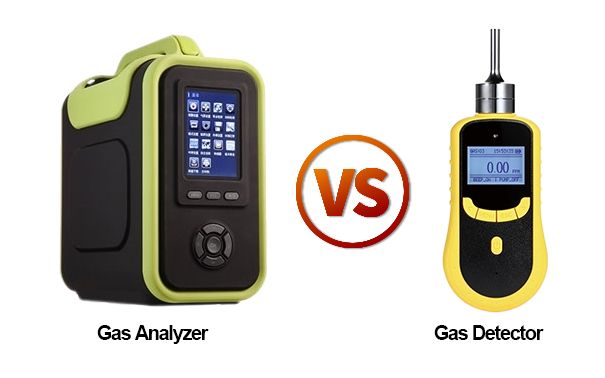Gas detectors and gas analyzers are two types of instruments used to deal with gas-related tasks, and although both gas detectors and gas analyzers are involved in dealing with gases, their main objectives, application scenarios and functions are very different. Next, we'll explore the differences in more detail.
A gas detector is a device used to detect harmful gas leaks or abnormal concentrations. It is mainly used in the field of safety and protection to ensure that there is no leakage or excessive concentration of dangerous gases in the working environment. It can detect a variety of toxic gases, such as Hydrogen (H2), Hydrogen Sulfide (H2S), Ammonia (NH3), Chlorine (CL2), etc. When the gas concentration reaches the set alarm threshold, the gas detector will sound an alarm to inform the operator to take necessary safety measures, such as evacuation or wearing a breathing apparatus.
A gas analyzer is a process analysis instrument used to measure the composition of gases and is also used to detect the composition of gases, such as the composition of flue gas. It can measure multiple gases, including but not limited to Oxygen (O2), Carbon Dioxide (CO2), Nitrogen (N2), Methane (CH4), Carbon Monoxide (CO), etc. These devices are usually equipped with high-precision precision sensors that can accurately measure the concentration of gas components.
Difference Between Gas Detector and Gas Analyzer
Structure: The structure of the gas detector is simple, and it is generally composed of the detection probe (gas sensor) and the sensor signal conversion circuit. The gas analyzer is not only equipped with a detection probe (gas sensor) inside, but also a complete gas path analysis system, which introduces the sample gas into the instrument, and then exhausts the gas after sampling is completed.

Measurement Objects: Gas detectors are usually used to detect and monitor the presence of specific gases (such as toxic gases, combustible gases, etc.) and their concentrations in the environment to ensure the safety of the working environment. The gas analyzer mainly analyzes the composition and content of the gas in the measured environment. They are commonly used in research laboratories, industrial production processes, environmental monitoring and other applications that require high-precision gas composition analysis.
Detection Method: The detection method of the gas detector is usually diffusion, and uses the probe directly exposed to the measured air for detection. The gas analyzer introduces the measured gas into the instrument through a special way for measurement and then releases it outside the instrument after the measurement is completed.
Control Mode of Measurement Conditions: The gas detector does not involve the adjustment and control part of the technical conditions of the sample gas process, and at the same time, it does not consider the environmental conditions of the sample gas and directly detects the gas. The gas analyzer is equipped with a complete set of gas circuit systems and external supporting equipment to form a complete set of chemical process flows. The gas analysis instrument adjusts and controls the working conditions of the sample gas in an all-round way, so that the sensor can achieve normal and stable work, which is also the main reason why the gas analyzer can accurately obtain measurement data.
Operation Method of the Measurement Process: When using a gas detector, simply place it in the environment under test, the instrument can display the value and complete the detection. The gas analyzer must introduce the sample gas into the instrument, and then strictly adjust the process technical conditions, such as temperature, pressure, flow, etc., to obtain accurate measurement data.
Elimination of Interference Factors to Consider the Way: The gas detector directly places the sensor in the measured environment for measurement, and does not consider whether there are interference factors in the design and practical application of the instrument structure, and does not have the design ability to exclude various interference factors. When the gas analyzer is designed, selected and used for testing, various internal and external factors affecting the measurement must be fully considered, only in this way can the accuracy and authenticity of the test data be ensured.
Accuracy of Data: Gas detector can only provide qualitative analysis results and relatively rough quantitative analysis data, and the data obtained by this instrument cannot be analyzed for error. However, it can be used as the basis for qualitative detection, such as a signal alarm when a certain concentration is reached. Gas analyzer is a precision measurement tool with high precision and high resolution. When conducting quantitative analysis, they can quantitatively measure the concentration of each gas in the gas mixture, providing very accurate data. This kind of data can be used as the basis for industrial production, natural gas production, safety and environmental protection improvement, and guide and implement production management, quality management and enterprise management.
Application: Gas detector is widely used in industry, safety monitoring, emergency response and environmental protection. For example, in chemical plants, mines, storage tank areas, sewers and fire fighting, gas detector is used to detect gas leaks or abnormal concentrations that could pose a danger to human health and the environment. Gas analyzer is mainly used in laboratories, industrial production, environmental monitoring, atmospheric science research and quality control and other fields. It is used to quantitatively analyze the composition of gas mixtures to support specific research or production processes.
Conclusion
In general, a gas analyzer is mainly used in laboratories, industry and scientific research to accurately measure the concentration of gas components, while a gas detector is mainly used in industrial safety and environmental monitoring to detect leakage of hazardous gases for the safety of personnel. Both instruments have different functions and importance in different application scenarios.
